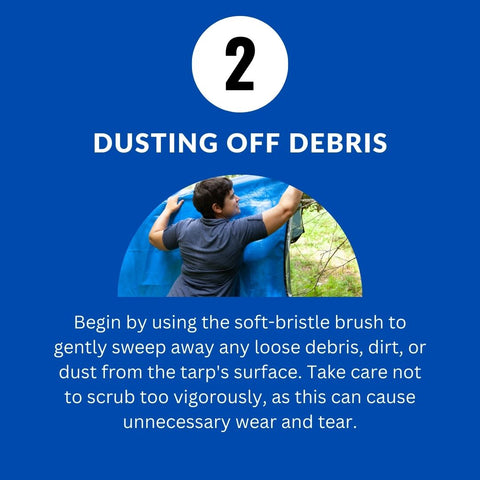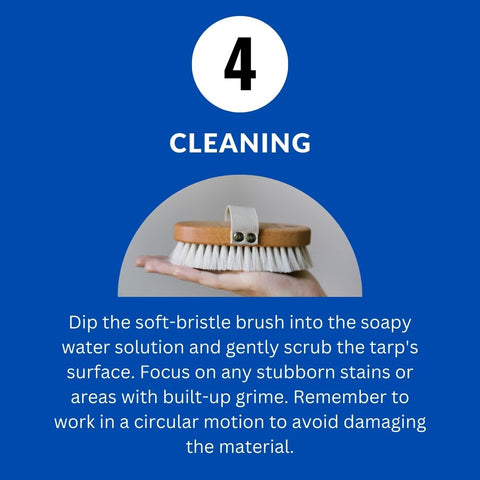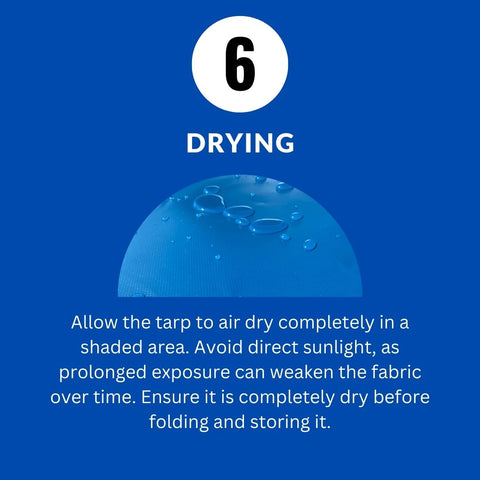When it comes to heavy-duty tarpaulin upkeep, we grasp the significance of ensuring they stay in excellent shape especially when they are only used seasonally. Whether you employ them for construction ventures, outdoor gatherings, or any other application, it's crucial to provide the right care and maintenance to prolong their longevity. In this all-encompassing article, we will guide you through the process of efficiently cleaning your heavy-duty tarpaulins, insuring their continued durability and reliability.
Gathering the Essentials
1. Heavy-Duty Tarpaulin
The tarpaulin you intend to clean.
2. Soft Bristle Brush
A soft-bristle brush helps remove loose debris and dirt without causing damage to the tarp.
3. Mild Soap or Detergent
Opt for a mild, non-abrasive soap or detergent. Harsh chemicals can weaken the tarp material.
4. Water Hose
You'll need a source of clean, cold water for rinsing.
5. Bucket
A bucket for mixing soap and water.
6. Protective Gear
Gloves to protect your hands and appropriate clothing to shield yourself from dirt and chemicals.
Cleaning Heavy-Duty Tarpaulins: Step-by-Step
Now that you have all the necessary supplies, let's delve into the cleaning process itself. Follow these steps to ensure a thorough clean:
Step 1: Preparation

Before starting, unfold the tarpaulin on a clean, flat surface. Ensure there are no sharp objects underneath that could damage the fabric.
Step 2: Dusting Off Debris

Begin by using the soft-bristle brush to gently sweep away any loose debris, dirt, or dust from the tarp's surface. Take care not to scrub too vigorously, as this can cause unnecessary wear and tear.
Step 3: Soap and Water Solution

Fill your bucket with cold water and add a small amount of mild soap or detergent. Mix the solution until it forms a soapy consistency. Avoid using hot water, as it may cause the tarpaulin to shrink.
Step 4: Cleaning

Dip the soft-bristle brush into the soapy water solution and gently scrub the tarp's surface. Focus on any stubborn stains or areas with built-up grime. Remember to work in a circular motion to avoid damaging the material.
Step 5: Rinsing

After scrubbing, rinse the tarpaulin thoroughly with clean, cold water from a hose. Ensure all soap residue is removed. A high-pressure hose attachment can be helpful for a more thorough rinse.
Step 6: Drying

Allow the tarp to air dry completely. Ensure it is completely dry before folding and storing it for the next time its used.
Additional Tips for Tarpaulin Maintenance
Regular Inspections: Periodically inspect your heavy-duty tarpaulins for any signs of damage or wear. Promptly repair any tears or holes using tarp repair kits or vinyl cement.
Storage: When not in use, store your tarpaulins in a cool, dry place. Avoid folding them when damp to prevent mildew growth.
Avoid Harsh Chemicals: Never use abrasive chemicals, bleach, or strong detergents when cleaning tarpaulins, as they can degrade the material.
UV Protection: Consider applying a UV protectant spray to extend the life of your tarpaulins, especially if they are exposed to the sun for extended periods.
Proper Folding: When storing your tarpaulins, fold them neatly to prevent creases and wrinkles that can weaken the material over time.
Kindly be advised that the following procedures are applicable for the cleaning of various tarpaulins, including super heavy-duty vinyl tarps, super heavy-duty poly tarps, and specific mesh tarps. It is imperative to exercise caution when considering cleaning methods for treated canvas tarps, as undertaking cleaning procedures may inadvertently compromise the fabric's water-resistant treatment. We recommend refraining from attempting to clean such treated canvas tarps in order to preserve their water-resistant properties.
In summary, it is of utmost importance to upkeep heavy-duty tarpaulins in order to secure their durability and top-notch performance. By adhering to the instructions provided in these recommendations and embracing sound maintenance practices, you can preserve the excellent condition of your tarpaulins for many years ahead.





